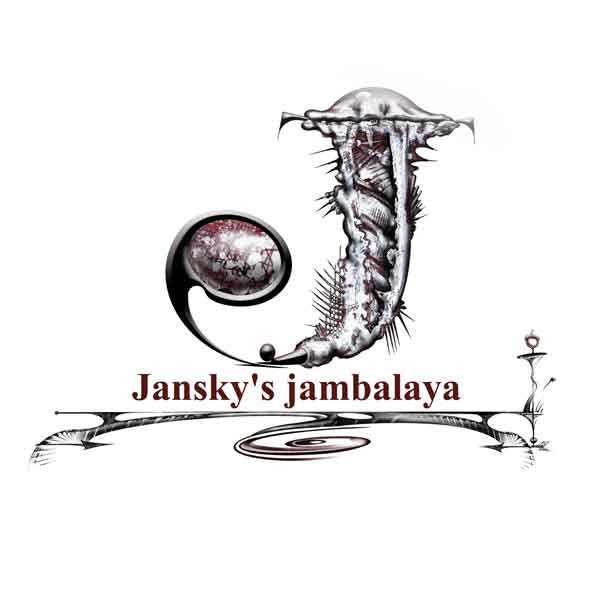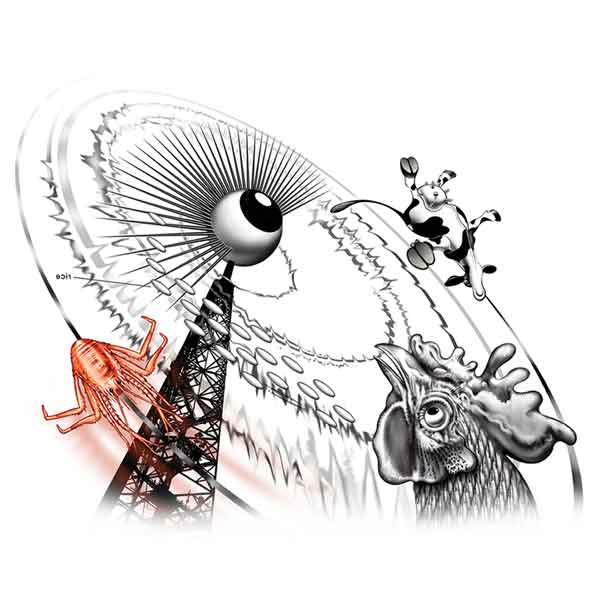cosmic concoction
by andy lanset

Jansky l Karl Guthe. 1905-50 engineer, a pioneer in radioastronomy.
Jansky l /jan-skee/ n. A unit of flux density for electromagnetic radiation, used chiefly in radioastronomy.
Jambalaya l /juhm-buh-lahy-uh/ n. A dish of Creole origin consisting of rice cooked with ham, sausage, chicken or shellfish, herb, spices, and vegetables.

*Quodlibetical Moments
Hollinger Box l n. A “document box” or “archives box,” is a specially constructed cardboard box used in archives for preservation of documents and photographs. The term “Hollinger” refers to the manufacturer, Hollinger Metal Edge, a company founded in 1945 in Arlington, Virginia. née adj. Originally called; born (used especially in adding a woman’s maiden name after her married name).
Superheterodyne l adj. In electronics, a superheterodyne receiver (often shortened to superhet) uses frequency mixing to convert a received signal to a fi ed intermediate frequency (IF) which can be more conveniently processed than the original carrier frequency. It was invented by US engineer Edwin Armstrong in 1918 during World War I.
Interstitial l n. An interstitial space or interstice is a space between structures or objects. Sine Wave n. A sine wave or sinusoid is a mathematical curve that describes a smooth repetitive oscillation. It is named after the function sine, of which it is the graph. It occurs often in pure and applied mathematics, as well as physics, engineering, signal processing, and many other fields.
Vernier l n. A device that lets the user measure more precisely than could be done unaided when reading a uniformly divided straight or circular measurement scale. Verniers are common on sextants used in navigation, scientific instruments used to conduct experiments, machinists’ measuring tools (all sorts, but especially calipers and micrometers) used to work materials to fine tolerances.
A young library school graduate was preparing a finding aid for the Karl Guthe Jansky papers. It was 1977 and she was carefully removing the staples and paperclips that had already left rusted shadows on the aging documents nestled in a row of gray Hollinger* boxes. There, deep in the cool compact shelving of the New Jersey telephone company where the physicist and radio engineer Karl Guthe Jansky (1905-1950) first discovered radio waves coming from the Milky Way in 1931, was the genesis of radio astronomy. There too, the source of acid reflux in Bell Lab’s lunchroom for years to come; enter Jansky’s jambalaya.
The archivist lifted a yellowed recipe from Jansky’s October 1934 lab notebook. It was in a woman’s script from another era and sandwiched between a memo for parabolic adhesives and his older brother Cyril Moreau Jansky’s schematic for 9XM. You see, Cyril helped design and build one of the earliest public radio transmitters in the country: 9XM in Wisconsin, now WHA. It appears that their mother, née* Nellie Moreau, was of French and English descent, with the French side having a distinct influen e on her sons’ taste buds as well as appetite for late night transmitting and receiving.
The power of this dish was obviously greater than the singular listing of its ingredients. In fact, Jansky family lore has it that Nellie would go into a trance-like state while preparing what one can only call a cosmic concoction. The cauldron was stirred clockwise and then counter-clockwise. The rising steam engulfed Nellie and spread out into the Jansky kitchen like the wake of a stone tossed into a placid pond. The spices and scents radiated outward with an eclectic yet universal message the brothers could internalize as the themes of brotherhood, dialogue and understanding. Who knew the stew would spew and imbue? For years the Jansky boys soaked up the regular Sunday meal, literally and figu atively, with wads of sourdough and the dreamy-eyed idealism of radiomen-without-borders, destined to be on a mission that would prove the point that you are indeed what you eat.
Like all good cooks, Nellie sampled her work as it progressed, and Karl Guthe reasoned that the jambalaya’s ingredients in combination with the amalgam-filled molars in Mama Jansky’s head were like superheterodynes* on a cat’s whisker. Before she found the jambalaya recipe in an old family bible, she thought she was just having a bout of tinnitus. But something in that recipe, in combination with those mercurial dental plugs, allowed her to hear heavenly voices with vernier*-like precision. They would speak to her like the medicine show barkers who passed through Norman, Oklahoma, where Karl Guthe was born; direct yet somehow reassuring that their elixir would be the solution to all infirmities: p ysical, mental and spiritual.
Afterwards, she would tell the shy Karl Guthe, “K.G.” she nagged, “Don’t let anyone tell you otherwise, you’ve got friends out there, you just have to listen more carefully!” To the talkative Cyril Moreau, she would say, “C.M., you’ve got a lot to say, but don’t try to sell anything.” Inspired by their mother and her jambalaya fueled reception, the Jansky boys set out on their respective radio endeavors.
C.M. became an early public radio talk show host doing pioneering work with both the pregnant pause and the deep sigh in the 1930s. By the time the Japanese attacked Pearl Harbor, he introduced the breathless gasp and seamless newscast corrective, ‘or rather,’ to on-the-spot reporting. And although it cannot be confirme , it is said he tutored Herb Morrison before the intrepid reporter covered the arrival of the doomed Hindenburg at Lakehurst, New Jersey. In the 1950s, C.M. had grown bitter and cynical, frequently bouncing from one station to another because he failed to put a smile in his voice and delivered less-than-perky newscasts with station IDs like, “And speaking of lying, cheating and murderous bastards, you’re listening to K.J.O.Y. at 88.7 FM.”
By the time Eisenhower was riding in the backseat with JFK down Pennsylvania Avenue, C.M. had exhausted his possibilities stateside and had joined a band of broadcast misfits at a 20 kilowatt pirate station on a houseboat in the Gulf of Mexico. XOXO a.k.a.”Hugs and Kisses Radio” was picking up significa t audience share from border radio, using a mix of stream-of-consciousness banter that can only be described as Jean Shepherd meets Alan Watts, who then meets Ira Glass: truly novel at any moment. Still, it was a time of experimentation and Jansky’s Jambalaya had acquired some new herbs and spices.
There was even talk of a restaurant in downtown Veracruz. But all things considered, C.M. decided to pack it in and take his engineering expertise and, now patented, jambalaya recipe to the University of Minnesota. It was there that he lionized K.G.’s work in the treatise: Brother Karl: Cosmology, Jambalaya and the Discovery of Radio Waves from Beyond the Earth.
Karl’s radio trajectory meanwhile was aimed at the heavens. But first things firs . As a typically sullen Oklahoma teenager towards the end of ‘the great war,’ he spent time listening to the white noise machine in his psychotherapist’s waiting room. It was actually good training. His future work and discoveries required a discriminating ear as he focused on his early studies of the interstitial* gaps in sine waves*, deep static and interference. After all, if he couldn’t tell the diffe ence between the 60 cycle hum of an ungrounded outlet and vital messages to our world from the next, what good would he be? Additional theoretical reassurance came from Arthur Schopenhauer’s essay on noise where the great man argued that, “Hammering, the barking of dogs, and the crying of children are horrible sounds; but your only genuine assassin of thought is the crack of a whip; it exists for the purpose of destroying every pleasant moment of quiet thought that anyone may now and then enjoy.” Fortunately for K.G. the intermittent buggy whip had pretty much gone the way of the local blacksmith as the regular humming of internal combustion engines and electric motors replaced natural horse power on our streets and highways.
Karl began work at the Bell Labs research field station in Cliff ood, New Jersey in 1928. It was there that he began tinkering with what would become the 14.6 meter rotatable directional antenna system and associated receiver. Shortly thereafter he started dating Esther Tumult, the daughter of one of his colleagues. They fell in love and married. He affe tionately called her E.T. and entrusted her with the jambalaya recipe, which she dutifully made every week for him to take to the lab. By April 1932 he presented his three classes of static before the the International Scientific Radio Union (ISRU) in Washington, D.C. This included near thunderstorms, far away thunderstorms, and an unidentified static. A year later, he had a breakthrough. With E.T.’s help, he drew on the jambalaya recipe for equivalent amounts of red curry powder and fennel and hit upon the formula for the critical ISO standard that would bear his name. The Jansky is equal to one-hundredth of one-trillionth of a trillionth of a watt per square meter per hertz. In scientific symbolic notation, this is expressed: 1 Jy = 10^(-26) W m^(-2) Hz^(-1)
With this standard, Karl presented his second paper before the ISRU: “Electrical Disturbances Apparently of Extraterrestrial Origin” and proved that this previously unidentified static and hiss came from the heart of the Milk Way. Karl also became the ping pong champion of Monmouth County, New Jersey.
Toward the end of his life, his E.T. would cook up the Sunday jambalaya for K.G. and C.M., who had come back east and retired to Hackensack. E.T. would say, “K.G., don’t let anyone tell you otherwise, you’ve got friends out there, you just have to listen more carefully!” To the talkative Cyril Moreau, she would say, “C.M., you’ve got a lot to say, but don’t try to sell anything.” Inspired by her jambalaya, the Jansky boys continued their respective radio endeavors.